Essay on Motivation: Theories, Factors, and Google's Practices
VerifiedAdded on 2022/12/29
|7
|2508
|55
Essay
AI Summary
This essay provides a comprehensive overview of motivation in an organizational context. It begins by defining motivation and its importance in influencing employee behavior and goal accomplishment. The essay then delves into two prominent motivational theories: Maslow's hierarchy of needs and Herzberg's two-factor theory. Maslow's theory is explained in detail, outlining the five levels of needs and their impact on motivation. Herzberg's theory is discussed, highlighting the differences between hygiene factors and motivators. The essay further explores the practical application of motivation theories, using Google as a case study to illustrate how companies can effectively motivate their employees through various strategies, including work culture, benefits, and innovative programs. The essay also differentiates between intrinsic and extrinsic motivation, providing examples of each. Finally, it concludes by summarizing the key concepts and emphasizing the significance of motivation in achieving organizational goals. The essay references various academic sources to support its arguments.
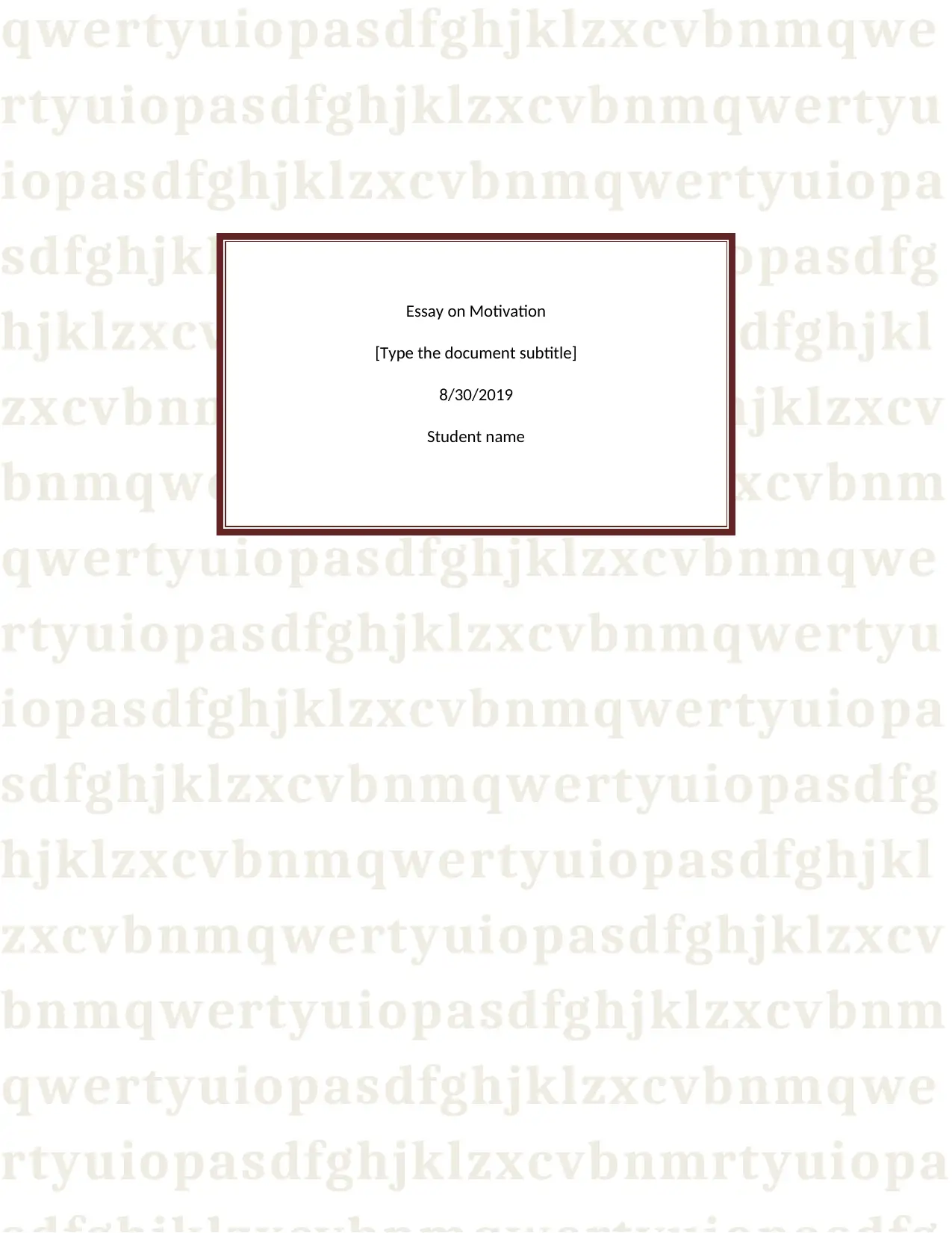
qwertyuiopasdfghjklzxcvbnmqwe
rtyuiopasdfghjklzxcvbnmqwertyu
iopasdfghjklzxcvbnmqwertyuiopa
sdfghjklzxcvbnmqwertyuiopasdfg
hjklzxcvbnmqwertyuiopasdfghjkl
zxcvbnmqwertyuiopasdfghjklzxcv
bnmqwertyuiopasdfghjklzxcvbnm
qwertyuiopasdfghjklzxcvbnmqwe
rtyuiopasdfghjklzxcvbnmqwertyu
iopasdfghjklzxcvbnmqwertyuiopa
sdfghjklzxcvbnmqwertyuiopasdfg
hjklzxcvbnmqwertyuiopasdfghjkl
zxcvbnmqwertyuiopasdfghjklzxcv
bnmqwertyuiopasdfghjklzxcvbnm
qwertyuiopasdfghjklzxcvbnmqwe
rtyuiopasdfghjklzxcvbnmrtyuiopa
Essay on Motivation
[Type the document subtitle]
8/30/2019
Student name
rtyuiopasdfghjklzxcvbnmqwertyu
iopasdfghjklzxcvbnmqwertyuiopa
sdfghjklzxcvbnmqwertyuiopasdfg
hjklzxcvbnmqwertyuiopasdfghjkl
zxcvbnmqwertyuiopasdfghjklzxcv
bnmqwertyuiopasdfghjklzxcvbnm
qwertyuiopasdfghjklzxcvbnmqwe
rtyuiopasdfghjklzxcvbnmqwertyu
iopasdfghjklzxcvbnmqwertyuiopa
sdfghjklzxcvbnmqwertyuiopasdfg
hjklzxcvbnmqwertyuiopasdfghjkl
zxcvbnmqwertyuiopasdfghjklzxcv
bnmqwertyuiopasdfghjklzxcvbnm
qwertyuiopasdfghjklzxcvbnmqwe
rtyuiopasdfghjklzxcvbnmrtyuiopa
Essay on Motivation
[Type the document subtitle]
8/30/2019
Student name
Paraphrase This Document
Need a fresh take? Get an instant paraphrase of this document with our AI Paraphraser
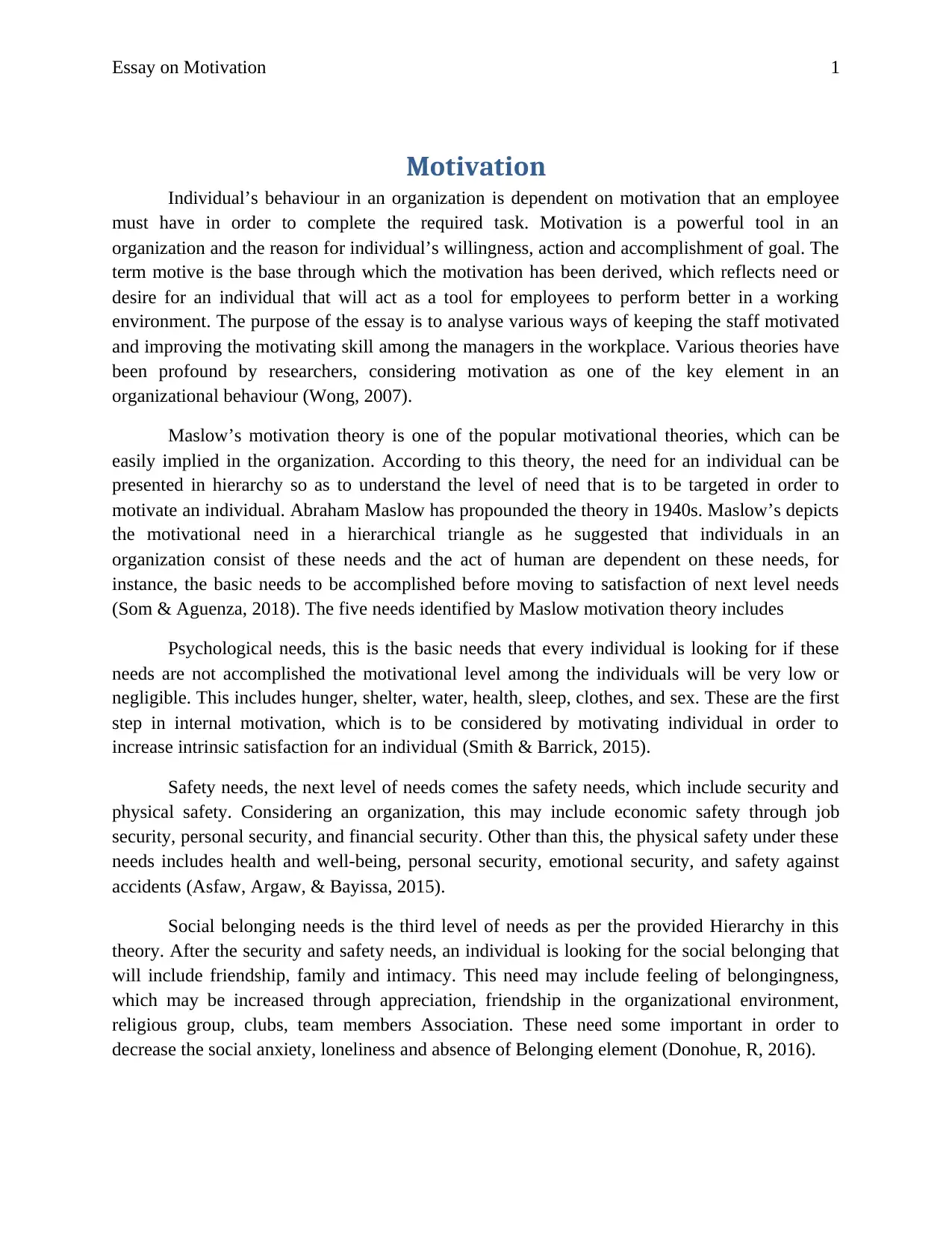
Essay on Motivation 1
Motivation
Individual’s behaviour in an organization is dependent on motivation that an employee
must have in order to complete the required task. Motivation is a powerful tool in an
organization and the reason for individual’s willingness, action and accomplishment of goal. The
term motive is the base through which the motivation has been derived, which reflects need or
desire for an individual that will act as a tool for employees to perform better in a working
environment. The purpose of the essay is to analyse various ways of keeping the staff motivated
and improving the motivating skill among the managers in the workplace. Various theories have
been profound by researchers, considering motivation as one of the key element in an
organizational behaviour (Wong, 2007).
Maslow’s motivation theory is one of the popular motivational theories, which can be
easily implied in the organization. According to this theory, the need for an individual can be
presented in hierarchy so as to understand the level of need that is to be targeted in order to
motivate an individual. Abraham Maslow has propounded the theory in 1940s. Maslow’s depicts
the motivational need in a hierarchical triangle as he suggested that individuals in an
organization consist of these needs and the act of human are dependent on these needs, for
instance, the basic needs to be accomplished before moving to satisfaction of next level needs
(Som & Aguenza, 2018). The five needs identified by Maslow motivation theory includes
Psychological needs, this is the basic needs that every individual is looking for if these
needs are not accomplished the motivational level among the individuals will be very low or
negligible. This includes hunger, shelter, water, health, sleep, clothes, and sex. These are the first
step in internal motivation, which is to be considered by motivating individual in order to
increase intrinsic satisfaction for an individual (Smith & Barrick, 2015).
Safety needs, the next level of needs comes the safety needs, which include security and
physical safety. Considering an organization, this may include economic safety through job
security, personal security, and financial security. Other than this, the physical safety under these
needs includes health and well-being, personal security, emotional security, and safety against
accidents (Asfaw, Argaw, & Bayissa, 2015).
Social belonging needs is the third level of needs as per the provided Hierarchy in this
theory. After the security and safety needs, an individual is looking for the social belonging that
will include friendship, family and intimacy. This need may include feeling of belongingness,
which may be increased through appreciation, friendship in the organizational environment,
religious group, clubs, team members Association. These need some important in order to
decrease the social anxiety, loneliness and absence of Belonging element (Donohue, R, 2016).
Motivation
Individual’s behaviour in an organization is dependent on motivation that an employee
must have in order to complete the required task. Motivation is a powerful tool in an
organization and the reason for individual’s willingness, action and accomplishment of goal. The
term motive is the base through which the motivation has been derived, which reflects need or
desire for an individual that will act as a tool for employees to perform better in a working
environment. The purpose of the essay is to analyse various ways of keeping the staff motivated
and improving the motivating skill among the managers in the workplace. Various theories have
been profound by researchers, considering motivation as one of the key element in an
organizational behaviour (Wong, 2007).
Maslow’s motivation theory is one of the popular motivational theories, which can be
easily implied in the organization. According to this theory, the need for an individual can be
presented in hierarchy so as to understand the level of need that is to be targeted in order to
motivate an individual. Abraham Maslow has propounded the theory in 1940s. Maslow’s depicts
the motivational need in a hierarchical triangle as he suggested that individuals in an
organization consist of these needs and the act of human are dependent on these needs, for
instance, the basic needs to be accomplished before moving to satisfaction of next level needs
(Som & Aguenza, 2018). The five needs identified by Maslow motivation theory includes
Psychological needs, this is the basic needs that every individual is looking for if these
needs are not accomplished the motivational level among the individuals will be very low or
negligible. This includes hunger, shelter, water, health, sleep, clothes, and sex. These are the first
step in internal motivation, which is to be considered by motivating individual in order to
increase intrinsic satisfaction for an individual (Smith & Barrick, 2015).
Safety needs, the next level of needs comes the safety needs, which include security and
physical safety. Considering an organization, this may include economic safety through job
security, personal security, and financial security. Other than this, the physical safety under these
needs includes health and well-being, personal security, emotional security, and safety against
accidents (Asfaw, Argaw, & Bayissa, 2015).
Social belonging needs is the third level of needs as per the provided Hierarchy in this
theory. After the security and safety needs, an individual is looking for the social belonging that
will include friendship, family and intimacy. This need may include feeling of belongingness,
which may be increased through appreciation, friendship in the organizational environment,
religious group, clubs, team members Association. These need some important in order to
decrease the social anxiety, loneliness and absence of Belonging element (Donohue, R, 2016).
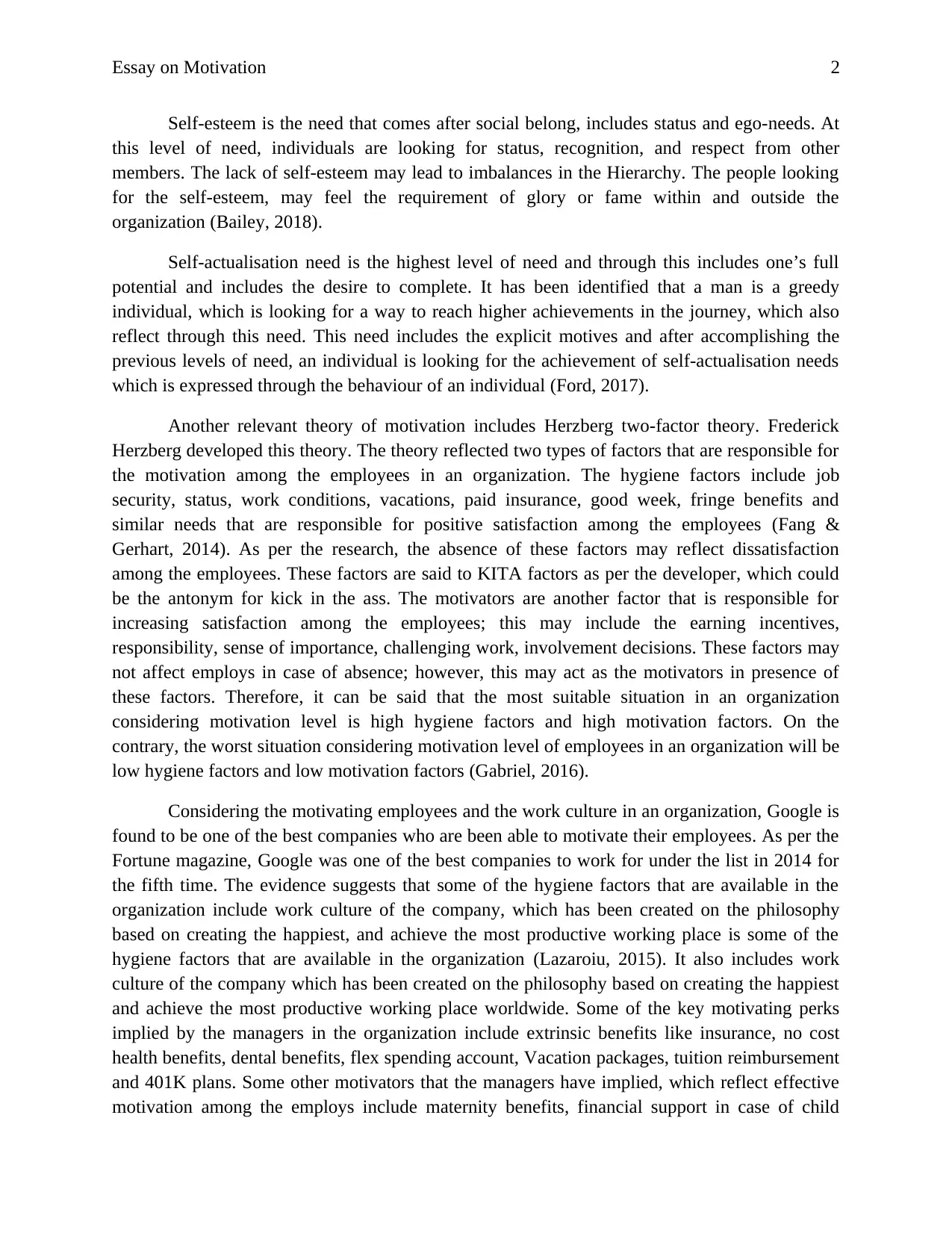
Essay on Motivation 2
Self-esteem is the need that comes after social belong, includes status and ego-needs. At
this level of need, individuals are looking for status, recognition, and respect from other
members. The lack of self-esteem may lead to imbalances in the Hierarchy. The people looking
for the self-esteem, may feel the requirement of glory or fame within and outside the
organization (Bailey, 2018).
Self-actualisation need is the highest level of need and through this includes one’s full
potential and includes the desire to complete. It has been identified that a man is a greedy
individual, which is looking for a way to reach higher achievements in the journey, which also
reflect through this need. This need includes the explicit motives and after accomplishing the
previous levels of need, an individual is looking for the achievement of self-actualisation needs
which is expressed through the behaviour of an individual (Ford, 2017).
Another relevant theory of motivation includes Herzberg two-factor theory. Frederick
Herzberg developed this theory. The theory reflected two types of factors that are responsible for
the motivation among the employees in an organization. The hygiene factors include job
security, status, work conditions, vacations, paid insurance, good week, fringe benefits and
similar needs that are responsible for positive satisfaction among the employees (Fang &
Gerhart, 2014). As per the research, the absence of these factors may reflect dissatisfaction
among the employees. These factors are said to KITA factors as per the developer, which could
be the antonym for kick in the ass. The motivators are another factor that is responsible for
increasing satisfaction among the employees; this may include the earning incentives,
responsibility, sense of importance, challenging work, involvement decisions. These factors may
not affect employs in case of absence; however, this may act as the motivators in presence of
these factors. Therefore, it can be said that the most suitable situation in an organization
considering motivation level is high hygiene factors and high motivation factors. On the
contrary, the worst situation considering motivation level of employees in an organization will be
low hygiene factors and low motivation factors (Gabriel, 2016).
Considering the motivating employees and the work culture in an organization, Google is
found to be one of the best companies who are been able to motivate their employees. As per the
Fortune magazine, Google was one of the best companies to work for under the list in 2014 for
the fifth time. The evidence suggests that some of the hygiene factors that are available in the
organization include work culture of the company, which has been created on the philosophy
based on creating the happiest, and achieve the most productive working place is some of the
hygiene factors that are available in the organization (Lazaroiu, 2015). It also includes work
culture of the company which has been created on the philosophy based on creating the happiest
and achieve the most productive working place worldwide. Some of the key motivating perks
implied by the managers in the organization include extrinsic benefits like insurance, no cost
health benefits, dental benefits, flex spending account, Vacation packages, tuition reimbursement
and 401K plans. Some other motivators that the managers have implied, which reflect effective
motivation among the employs include maternity benefits, financial support in case of child
Self-esteem is the need that comes after social belong, includes status and ego-needs. At
this level of need, individuals are looking for status, recognition, and respect from other
members. The lack of self-esteem may lead to imbalances in the Hierarchy. The people looking
for the self-esteem, may feel the requirement of glory or fame within and outside the
organization (Bailey, 2018).
Self-actualisation need is the highest level of need and through this includes one’s full
potential and includes the desire to complete. It has been identified that a man is a greedy
individual, which is looking for a way to reach higher achievements in the journey, which also
reflect through this need. This need includes the explicit motives and after accomplishing the
previous levels of need, an individual is looking for the achievement of self-actualisation needs
which is expressed through the behaviour of an individual (Ford, 2017).
Another relevant theory of motivation includes Herzberg two-factor theory. Frederick
Herzberg developed this theory. The theory reflected two types of factors that are responsible for
the motivation among the employees in an organization. The hygiene factors include job
security, status, work conditions, vacations, paid insurance, good week, fringe benefits and
similar needs that are responsible for positive satisfaction among the employees (Fang &
Gerhart, 2014). As per the research, the absence of these factors may reflect dissatisfaction
among the employees. These factors are said to KITA factors as per the developer, which could
be the antonym for kick in the ass. The motivators are another factor that is responsible for
increasing satisfaction among the employees; this may include the earning incentives,
responsibility, sense of importance, challenging work, involvement decisions. These factors may
not affect employs in case of absence; however, this may act as the motivators in presence of
these factors. Therefore, it can be said that the most suitable situation in an organization
considering motivation level is high hygiene factors and high motivation factors. On the
contrary, the worst situation considering motivation level of employees in an organization will be
low hygiene factors and low motivation factors (Gabriel, 2016).
Considering the motivating employees and the work culture in an organization, Google is
found to be one of the best companies who are been able to motivate their employees. As per the
Fortune magazine, Google was one of the best companies to work for under the list in 2014 for
the fifth time. The evidence suggests that some of the hygiene factors that are available in the
organization include work culture of the company, which has been created on the philosophy
based on creating the happiest, and achieve the most productive working place is some of the
hygiene factors that are available in the organization (Lazaroiu, 2015). It also includes work
culture of the company which has been created on the philosophy based on creating the happiest
and achieve the most productive working place worldwide. Some of the key motivating perks
implied by the managers in the organization include extrinsic benefits like insurance, no cost
health benefits, dental benefits, flex spending account, Vacation packages, tuition reimbursement
and 401K plans. Some other motivators that the managers have implied, which reflect effective
motivation among the employs include maternity benefits, financial support in case of child
⊘ This is a preview!⊘
Do you want full access?
Subscribe today to unlock all pages.

Trusted by 1+ million students worldwide
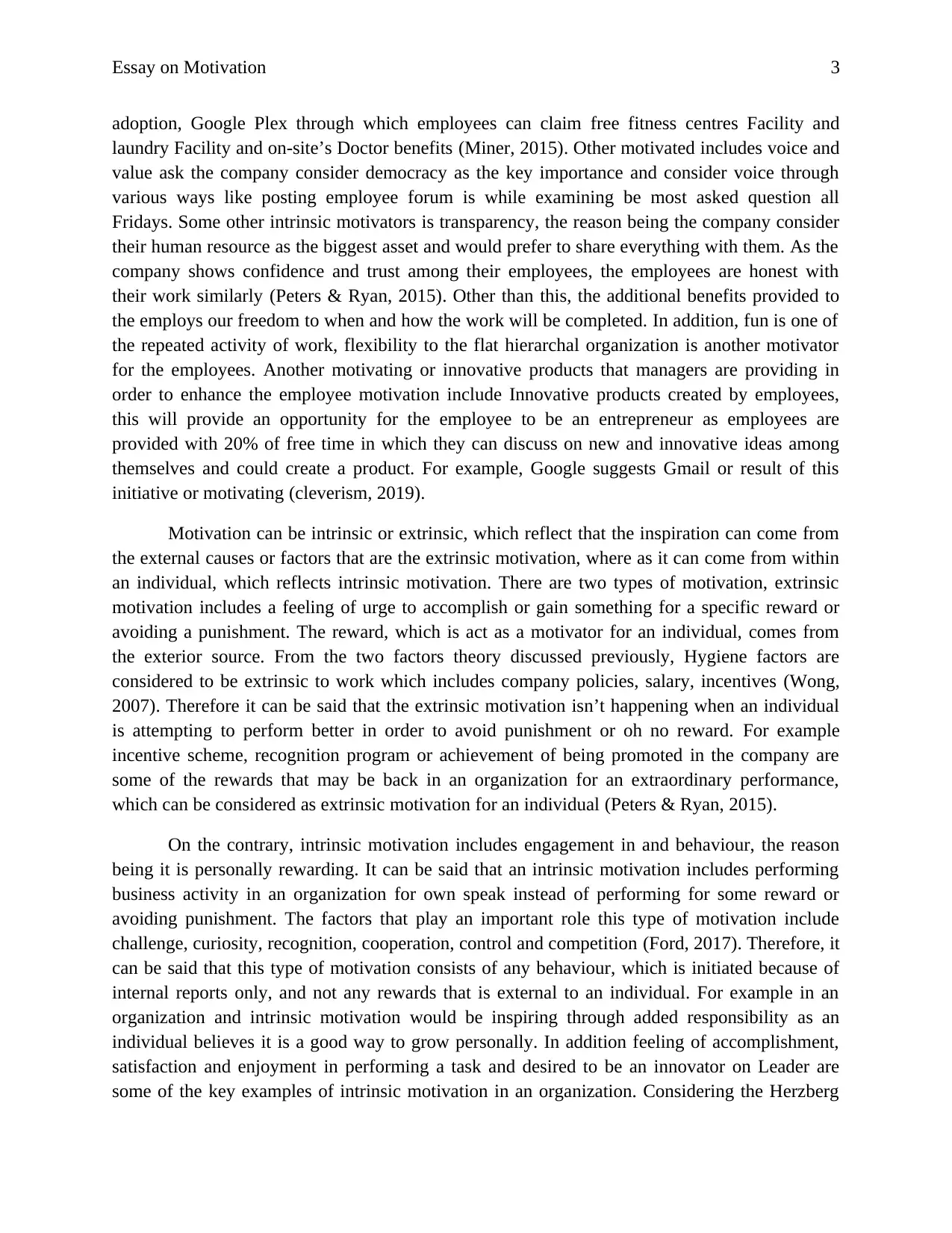
Essay on Motivation 3
adoption, Google Plex through which employees can claim free fitness centres Facility and
laundry Facility and on-site’s Doctor benefits (Miner, 2015). Other motivated includes voice and
value ask the company consider democracy as the key importance and consider voice through
various ways like posting employee forum is while examining be most asked question all
Fridays. Some other intrinsic motivators is transparency, the reason being the company consider
their human resource as the biggest asset and would prefer to share everything with them. As the
company shows confidence and trust among their employees, the employees are honest with
their work similarly (Peters & Ryan, 2015). Other than this, the additional benefits provided to
the employs our freedom to when and how the work will be completed. In addition, fun is one of
the repeated activity of work, flexibility to the flat hierarchal organization is another motivator
for the employees. Another motivating or innovative products that managers are providing in
order to enhance the employee motivation include Innovative products created by employees,
this will provide an opportunity for the employee to be an entrepreneur as employees are
provided with 20% of free time in which they can discuss on new and innovative ideas among
themselves and could create a product. For example, Google suggests Gmail or result of this
initiative or motivating (cleverism, 2019).
Motivation can be intrinsic or extrinsic, which reflect that the inspiration can come from
the external causes or factors that are the extrinsic motivation, where as it can come from within
an individual, which reflects intrinsic motivation. There are two types of motivation, extrinsic
motivation includes a feeling of urge to accomplish or gain something for a specific reward or
avoiding a punishment. The reward, which is act as a motivator for an individual, comes from
the exterior source. From the two factors theory discussed previously, Hygiene factors are
considered to be extrinsic to work which includes company policies, salary, incentives (Wong,
2007). Therefore it can be said that the extrinsic motivation isn’t happening when an individual
is attempting to perform better in order to avoid punishment or oh no reward. For example
incentive scheme, recognition program or achievement of being promoted in the company are
some of the rewards that may be back in an organization for an extraordinary performance,
which can be considered as extrinsic motivation for an individual (Peters & Ryan, 2015).
On the contrary, intrinsic motivation includes engagement in and behaviour, the reason
being it is personally rewarding. It can be said that an intrinsic motivation includes performing
business activity in an organization for own speak instead of performing for some reward or
avoiding punishment. The factors that play an important role this type of motivation include
challenge, curiosity, recognition, cooperation, control and competition (Ford, 2017). Therefore, it
can be said that this type of motivation consists of any behaviour, which is initiated because of
internal reports only, and not any rewards that is external to an individual. For example in an
organization and intrinsic motivation would be inspiring through added responsibility as an
individual believes it is a good way to grow personally. In addition feeling of accomplishment,
satisfaction and enjoyment in performing a task and desired to be an innovator on Leader are
some of the key examples of intrinsic motivation in an organization. Considering the Herzberg
adoption, Google Plex through which employees can claim free fitness centres Facility and
laundry Facility and on-site’s Doctor benefits (Miner, 2015). Other motivated includes voice and
value ask the company consider democracy as the key importance and consider voice through
various ways like posting employee forum is while examining be most asked question all
Fridays. Some other intrinsic motivators is transparency, the reason being the company consider
their human resource as the biggest asset and would prefer to share everything with them. As the
company shows confidence and trust among their employees, the employees are honest with
their work similarly (Peters & Ryan, 2015). Other than this, the additional benefits provided to
the employs our freedom to when and how the work will be completed. In addition, fun is one of
the repeated activity of work, flexibility to the flat hierarchal organization is another motivator
for the employees. Another motivating or innovative products that managers are providing in
order to enhance the employee motivation include Innovative products created by employees,
this will provide an opportunity for the employee to be an entrepreneur as employees are
provided with 20% of free time in which they can discuss on new and innovative ideas among
themselves and could create a product. For example, Google suggests Gmail or result of this
initiative or motivating (cleverism, 2019).
Motivation can be intrinsic or extrinsic, which reflect that the inspiration can come from
the external causes or factors that are the extrinsic motivation, where as it can come from within
an individual, which reflects intrinsic motivation. There are two types of motivation, extrinsic
motivation includes a feeling of urge to accomplish or gain something for a specific reward or
avoiding a punishment. The reward, which is act as a motivator for an individual, comes from
the exterior source. From the two factors theory discussed previously, Hygiene factors are
considered to be extrinsic to work which includes company policies, salary, incentives (Wong,
2007). Therefore it can be said that the extrinsic motivation isn’t happening when an individual
is attempting to perform better in order to avoid punishment or oh no reward. For example
incentive scheme, recognition program or achievement of being promoted in the company are
some of the rewards that may be back in an organization for an extraordinary performance,
which can be considered as extrinsic motivation for an individual (Peters & Ryan, 2015).
On the contrary, intrinsic motivation includes engagement in and behaviour, the reason
being it is personally rewarding. It can be said that an intrinsic motivation includes performing
business activity in an organization for own speak instead of performing for some reward or
avoiding punishment. The factors that play an important role this type of motivation include
challenge, curiosity, recognition, cooperation, control and competition (Ford, 2017). Therefore, it
can be said that this type of motivation consists of any behaviour, which is initiated because of
internal reports only, and not any rewards that is external to an individual. For example in an
organization and intrinsic motivation would be inspiring through added responsibility as an
individual believes it is a good way to grow personally. In addition feeling of accomplishment,
satisfaction and enjoyment in performing a task and desired to be an innovator on Leader are
some of the key examples of intrinsic motivation in an organization. Considering the Herzberg
Paraphrase This Document
Need a fresh take? Get an instant paraphrase of this document with our AI Paraphraser
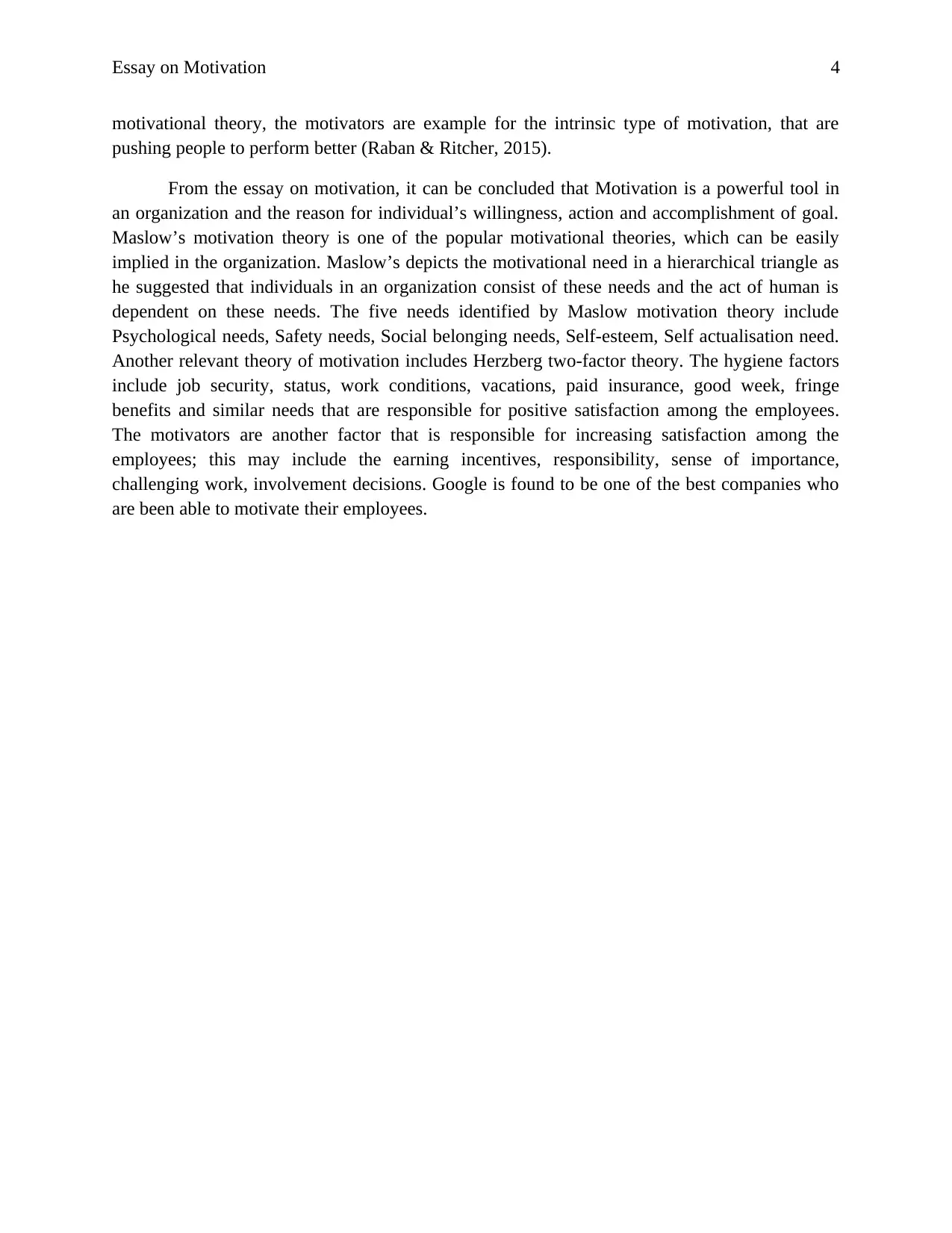
Essay on Motivation 4
motivational theory, the motivators are example for the intrinsic type of motivation, that are
pushing people to perform better (Raban & Ritcher, 2015).
From the essay on motivation, it can be concluded that Motivation is a powerful tool in
an organization and the reason for individual’s willingness, action and accomplishment of goal.
Maslow’s motivation theory is one of the popular motivational theories, which can be easily
implied in the organization. Maslow’s depicts the motivational need in a hierarchical triangle as
he suggested that individuals in an organization consist of these needs and the act of human is
dependent on these needs. The five needs identified by Maslow motivation theory include
Psychological needs, Safety needs, Social belonging needs, Self-esteem, Self actualisation need.
Another relevant theory of motivation includes Herzberg two-factor theory. The hygiene factors
include job security, status, work conditions, vacations, paid insurance, good week, fringe
benefits and similar needs that are responsible for positive satisfaction among the employees.
The motivators are another factor that is responsible for increasing satisfaction among the
employees; this may include the earning incentives, responsibility, sense of importance,
challenging work, involvement decisions. Google is found to be one of the best companies who
are been able to motivate their employees.
motivational theory, the motivators are example for the intrinsic type of motivation, that are
pushing people to perform better (Raban & Ritcher, 2015).
From the essay on motivation, it can be concluded that Motivation is a powerful tool in
an organization and the reason for individual’s willingness, action and accomplishment of goal.
Maslow’s motivation theory is one of the popular motivational theories, which can be easily
implied in the organization. Maslow’s depicts the motivational need in a hierarchical triangle as
he suggested that individuals in an organization consist of these needs and the act of human is
dependent on these needs. The five needs identified by Maslow motivation theory include
Psychological needs, Safety needs, Social belonging needs, Self-esteem, Self actualisation need.
Another relevant theory of motivation includes Herzberg two-factor theory. The hygiene factors
include job security, status, work conditions, vacations, paid insurance, good week, fringe
benefits and similar needs that are responsible for positive satisfaction among the employees.
The motivators are another factor that is responsible for increasing satisfaction among the
employees; this may include the earning incentives, responsibility, sense of importance,
challenging work, involvement decisions. Google is found to be one of the best companies who
are been able to motivate their employees.
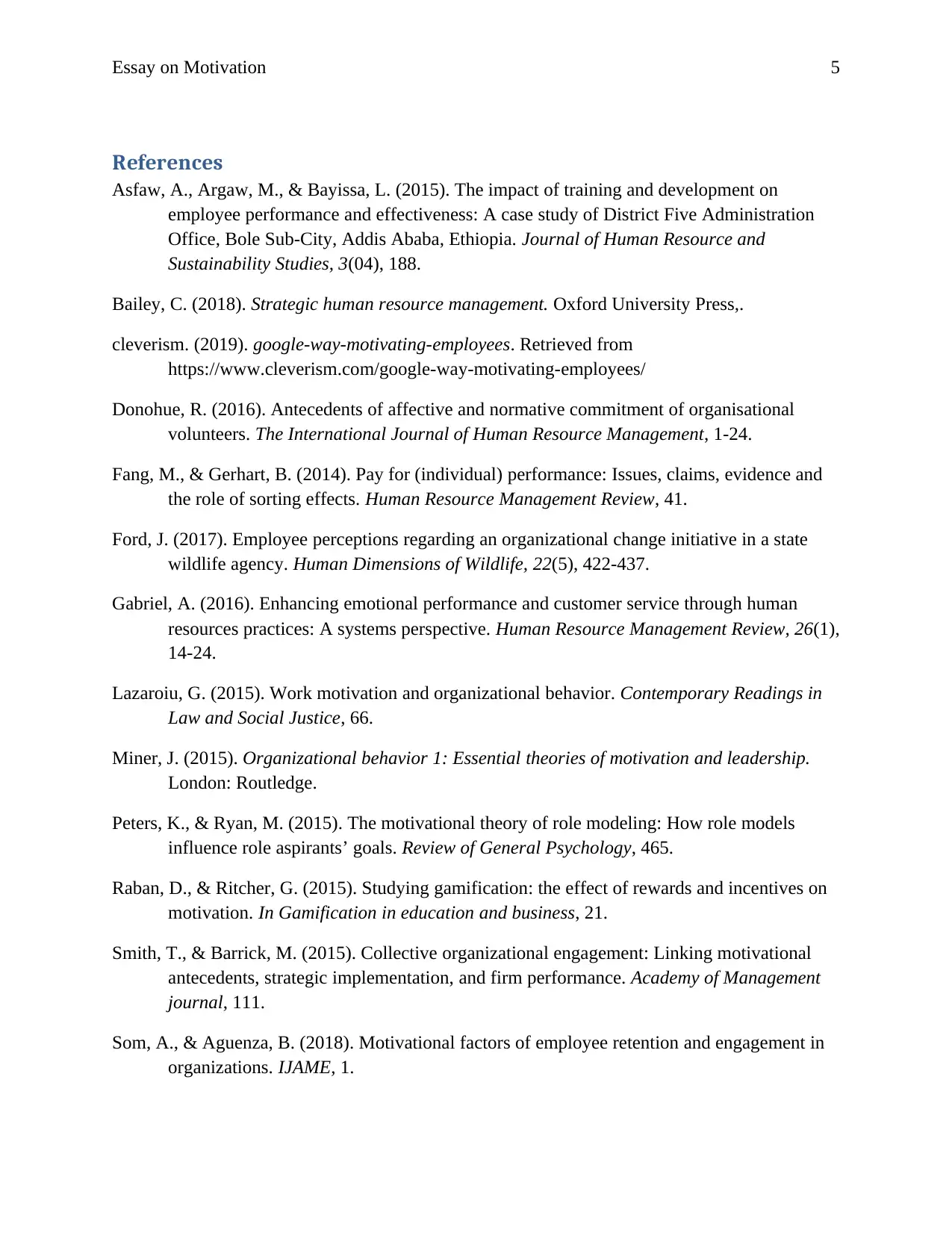
Essay on Motivation 5
References
Asfaw, A., Argaw, M., & Bayissa, L. (2015). The impact of training and development on
employee performance and effectiveness: A case study of District Five Administration
Office, Bole Sub-City, Addis Ababa, Ethiopia. Journal of Human Resource and
Sustainability Studies, 3(04), 188.
Bailey, C. (2018). Strategic human resource management. Oxford University Press,.
cleverism. (2019). google-way-motivating-employees. Retrieved from
https://www.cleverism.com/google-way-motivating-employees/
Donohue, R. (2016). Antecedents of affective and normative commitment of organisational
volunteers. The International Journal of Human Resource Management, 1-24.
Fang, M., & Gerhart, B. (2014). Pay for (individual) performance: Issues, claims, evidence and
the role of sorting effects. Human Resource Management Review, 41.
Ford, J. (2017). Employee perceptions regarding an organizational change initiative in a state
wildlife agency. Human Dimensions of Wildlife, 22(5), 422-437.
Gabriel, A. (2016). Enhancing emotional performance and customer service through human
resources practices: A systems perspective. Human Resource Management Review, 26(1),
14-24.
Lazaroiu, G. (2015). Work motivation and organizational behavior. Contemporary Readings in
Law and Social Justice, 66.
Miner, J. (2015). Organizational behavior 1: Essential theories of motivation and leadership.
London: Routledge.
Peters, K., & Ryan, M. (2015). The motivational theory of role modeling: How role models
influence role aspirants’ goals. Review of General Psychology, 465.
Raban, D., & Ritcher, G. (2015). Studying gamification: the effect of rewards and incentives on
motivation. In Gamification in education and business, 21.
Smith, T., & Barrick, M. (2015). Collective organizational engagement: Linking motivational
antecedents, strategic implementation, and firm performance. Academy of Management
journal, 111.
Som, A., & Aguenza, B. (2018). Motivational factors of employee retention and engagement in
organizations. IJAME, 1.
References
Asfaw, A., Argaw, M., & Bayissa, L. (2015). The impact of training and development on
employee performance and effectiveness: A case study of District Five Administration
Office, Bole Sub-City, Addis Ababa, Ethiopia. Journal of Human Resource and
Sustainability Studies, 3(04), 188.
Bailey, C. (2018). Strategic human resource management. Oxford University Press,.
cleverism. (2019). google-way-motivating-employees. Retrieved from
https://www.cleverism.com/google-way-motivating-employees/
Donohue, R. (2016). Antecedents of affective and normative commitment of organisational
volunteers. The International Journal of Human Resource Management, 1-24.
Fang, M., & Gerhart, B. (2014). Pay for (individual) performance: Issues, claims, evidence and
the role of sorting effects. Human Resource Management Review, 41.
Ford, J. (2017). Employee perceptions regarding an organizational change initiative in a state
wildlife agency. Human Dimensions of Wildlife, 22(5), 422-437.
Gabriel, A. (2016). Enhancing emotional performance and customer service through human
resources practices: A systems perspective. Human Resource Management Review, 26(1),
14-24.
Lazaroiu, G. (2015). Work motivation and organizational behavior. Contemporary Readings in
Law and Social Justice, 66.
Miner, J. (2015). Organizational behavior 1: Essential theories of motivation and leadership.
London: Routledge.
Peters, K., & Ryan, M. (2015). The motivational theory of role modeling: How role models
influence role aspirants’ goals. Review of General Psychology, 465.
Raban, D., & Ritcher, G. (2015). Studying gamification: the effect of rewards and incentives on
motivation. In Gamification in education and business, 21.
Smith, T., & Barrick, M. (2015). Collective organizational engagement: Linking motivational
antecedents, strategic implementation, and firm performance. Academy of Management
journal, 111.
Som, A., & Aguenza, B. (2018). Motivational factors of employee retention and engagement in
organizations. IJAME, 1.
⊘ This is a preview!⊘
Do you want full access?
Subscribe today to unlock all pages.

Trusted by 1+ million students worldwide
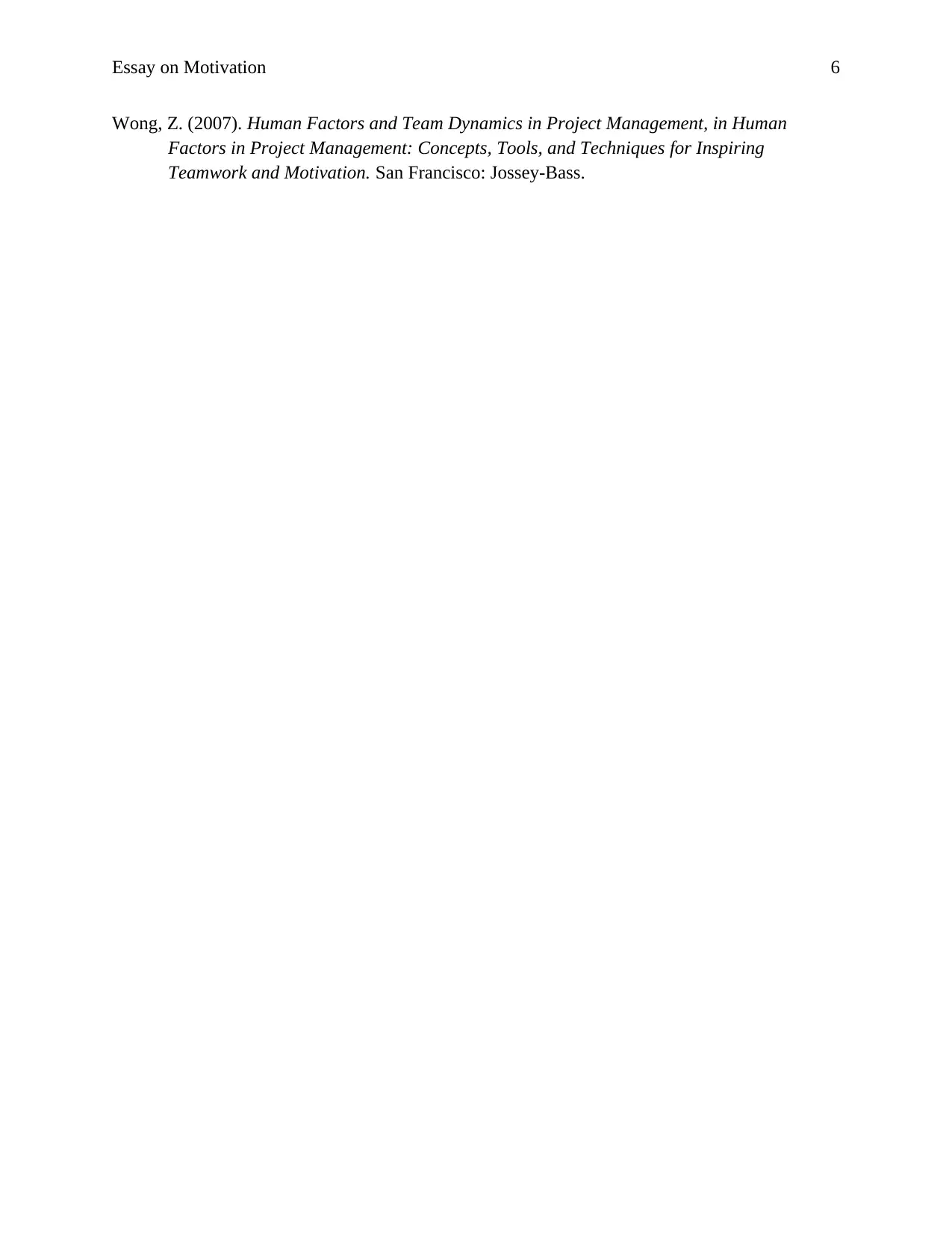
Essay on Motivation 6
Wong, Z. (2007). Human Factors and Team Dynamics in Project Management, in Human
Factors in Project Management: Concepts, Tools, and Techniques for Inspiring
Teamwork and Motivation. San Francisco: Jossey-Bass.
Wong, Z. (2007). Human Factors and Team Dynamics in Project Management, in Human
Factors in Project Management: Concepts, Tools, and Techniques for Inspiring
Teamwork and Motivation. San Francisco: Jossey-Bass.
1 out of 7
Related Documents
Your All-in-One AI-Powered Toolkit for Academic Success.
+13062052269
info@desklib.com
Available 24*7 on WhatsApp / Email
![[object Object]](/_next/static/media/star-bottom.7253800d.svg)
Unlock your academic potential
Copyright © 2020–2025 A2Z Services. All Rights Reserved. Developed and managed by ZUCOL.



